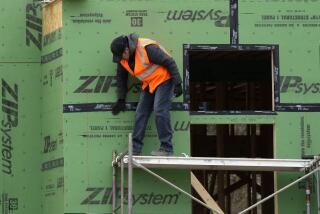Coasts Lag in the Latest Income Data : Economy: New data also shows an unexpected drop in jobless claims.
- Share via
WASHINGTON — Rocky Mountain states and other parts of the American heartland are weathering economic hard times better than the once-booming East and West coasts, the government said Thursday.
With some exceptions, states that flourished during the “bicoastal economy” of the 1980s now are struggling the most to shake off the recession’s grip, according to personal income data published by the Commerce Department.
“The bicoastal economy is certainly a thing of the past,” said economist Mark Zandi of Regional Financial Associates Inc. in West Chester, Pa. “Clearly the coasts are paying for the excesses of the 1980s.”
Zandi said growth in California and New England in particular had depended on a brief commercial construction spree, on defense spending--since decimated by the end of the Cold War--and on the now-busted financial services boom.
“The Midwest and the mountain states didn’t really take part in that and now they don’t have to pay the piper,” Zandi said.
In another report, the government reported Thursday that the number of Americans filing new claims for jobless benefits unexpectedly fell to 368,000 in early October, the lowest level in more than two years.
The Labor Department said the 15,000-claim decline during the week ended Oct. 10 was the third straight drop. Many analysts had predicted a 15,000 increase in applications for unemployment insurance.
The previous low was 367,000 during the week ended Aug. 11, 1990.
Among the country’s eight regions, New England had the slowest growth in personal income from the April-June quarter of 1991 to the same quarter of this year--3.9%, the Commerce Department said.
In the Far West, growth averaged just 4%. Weak 3.3% growth in California offset strong 6%-plus growth in the Pacific Northwest.
The Rocky Mountain states, with 6.3% income growth, had the best showing over the period.
The other regions weren’t far off the national average of 4.7%. Growth was 5.1% in both the Plains and the Southeast. It was 5% in the Southwest, 4.8% in the Mid-Atlantic region and 4.7% in Great Lakes states.
By state, Delaware had the slowest income growth--2.7%--during the year ended June 30. Montana, at 8.4%, had the fastest.
After Delaware, the slowest-growing states were Connecticut, California, Illinois, Nebraska, Florida, Maryland, Massachusetts, Michigan and North Dakota.
Zandi said Florida and some of the Northeastern states with high populations of retirees have been hurt by sharp declines in interest income.
“In Florida, one in every five dollars comes from interest income,” he said.
After Montana, the fastest-growing states were Utah, Nevada, Washington, South Dakota, Kentucky, Idaho, Oregon, Mississippi and North Carolina.
Dederick said the mountain states probably are benefiting from the migration of businesses seeking to avoid the high costs of California.
Personal income, which is reported monthly on a national basis, includes wages, interest income, government payments such as Social Security, business owners’ income and farmers’ income.
More to Read
Inside the business of entertainment
The Wide Shot brings you news, analysis and insights on everything from streaming wars to production — and what it all means for the future.
You may occasionally receive promotional content from the Los Angeles Times.










